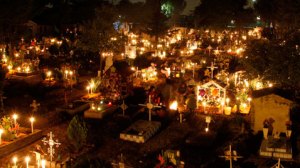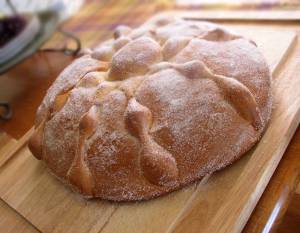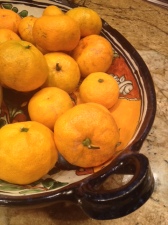While miniature American versions of superheroes, pirates and princesses head home to sleep off sugar-induced comas, Latin Americans south of the border flood into graveyards with candles, skeletons and mariachis.
Instead of the spooks and frights of Halloween, millions throughout Latin America celebrate the Day of the Dead on Nov. 1 and 2, a commemoration of friends and family members who have died.
“It’s not a morbid celebration at all,” history professor Stephen Andes said as he described celebrating the Day of the Dead in Sonora, Mexico. “At its core, it’s a celebration for family to get together to make a link with loved ones – even after they’re gone.”
During the two-day holiday, families visit the graves of deceased loved ones to clean the tombstones and decorate the sites with bright flowers and candles.

Celebrants work throughout the night.
Food contributes to a carnival-like atmosphere.
“There’s food vendors selling tamales and traditional candies like calaveras, or skulls made out of sugar,” Andes said.

Sugar skull candies range in intricacy.
Celebrants decorate the tombs and homemade altars with items that represent the deceased, Spanish professor and Costa Rican-native Lidia Byrd said.
“If they liked fruit, there’s fruit,” she said laughing. “If they liked tortillas, there are tortillas. If they liked mariachi, there are mariachis playing near the grave.”
Families also make pan de muerto, or bread of the dead, to eat at the gravesites, Byrd described. The sweet bread is flavored with anise seeds and decorated with sugar and bread pieces shaped like bones, which symbolize the dead.

Pan de muerto is traditionally served with coffee or hot chocolate.
The Day of the Dead’s emphasis on life is after death is a result of Mexican indigenous religions rather than a traditional part of Roman Catholicism.
“For us, when someone dies it is a continuation of the life,” Byrd said.
In an effort to obtain more Catholic converts, Spanish conquerors in the 1600s combined the Aztec celebration of the dead with the religious holidays of All Saint’s Day, Nov. 1, and All Soul’s day, Nov. 2.
The result, Andes said, is a holiday that is uniquely Latin American.
“I think you can see the Day of the Dead celebrates a lot more whimsical, lighthearted intimacy with death,” Andes said, contrasting the holiday to the American tradition of Halloween.
“Halloween is a completely different holiday. It’s all about being scary. They might be around the same time, but that’s not what Day of the Dead is about.”





